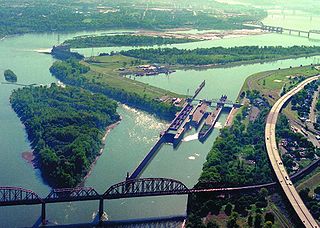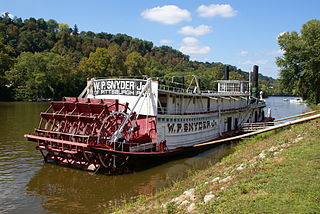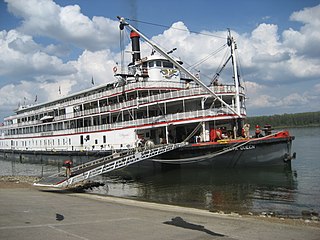Related Research Articles

A barge is a flat-bottomed boat, built mainly for river and canal transport of bulk goods. Originally barges were towed by draft horses on an adjacent towpath. Barges have changed throughout time. From 1967 to 1983 barges were considered a flat bottom boat that was nineteen feet in length or larger. Today, barges may be self-propelled, usually with a slow-revving diesel engine and a large-diameter fixed-pitch propeller. Otherwise, "dumb barges" must be towed by tugs, or pushed by pusher boats. Compared to a towed barge, a pusher system has improved handling and is more efficient, as the pushing tug becomes "part of the unit" and it contributes to the momentum of the whole.

SS Edmund Fitzgerald was an American Great Lakes freighter that sank in Lake Superior during a storm on November 10, 1975, with the loss of the entire crew of 29 men. When launched on June 7, 1958, she was the largest ship on North America's Great Lakes, and she remains the largest to have sunk there. She was located in deep water on November 14, 1975, by a U.S. Navy aircraft detecting magnetic anomalies, and found soon afterwards to be in two large pieces.

A pusher, pusher craft, pusher boat, pusher tug, or towboat, is a boat designed for pushing barges or car floats. In the United States, the industries that use these vessels refer to them as towboats. These vessels are characterized by a square bow, a shallow draft, and typically have knees, which are large plates mounted to the bow for pushing barges of various heights. These boats usually operate on rivers and inland waterways. Multiple barges lashed together, or a boat and any barges lashed to it, are referred to as a "tow" and can have dozens of barges. Many of these vessels, especially the long distances, or long haul boats, include living quarters for the crew.

CSS Baltic was a casemate ironclad that served in the Confederate States Navy during the American Civil War. A towboat and cotton lighter before the war, she was purchased by the state of Alabama in December 1861 for conversion into an ironclad. After being transferred over to the Confederate Navy in May 1862, she served on Mobile Bay off the Gulf of Mexico. The result of the conversion was a vessel that naval historian William N. Still Jr. has described as "a nondescript vessel in many ways". She deteriorated over the next two years and became rotten. Her armor was removed to put onto the ironclad CSS Nashville in 1864. By that August, she had been decommissioned, and was taken up the Tombigbee River near the end of the war, where she was captured by Union forces on May 10, 1865. An inspection the next month found that her upper hull and deck were rotten and that her boilers were unsafe. She was sold on December 31, and naval historian Saxon Bisbee believes that she was likely broken up in 1866.

Lake freighters, or lakers, are bulk carrier vessels that ply the Great Lakes of North America. These vessels are traditionally called boats, although classified as ships.

The McAlpine Locks and Dam are a set of locks and a hydroelectric dam at the Falls of the Ohio River at Louisville, Kentucky. They are located at mile point 606.8, and control a 72.9 miles (117.3 km) long navigation pool. The locks and their associated canal were the first major engineering project on the Ohio River, completed in 1830 as the Louisville and Portland Canal, designed to allow shipping traffic to navigate through the Falls of the Ohio.
Longtan Dam is a large roller-compacted concrete (RCC) gravity dam on the Hongshui River in Tian'e County of the Guangxi Zhuang Autonomous Region, China, a tributary of the Xi River and the Pearl River. The dam is 216.2 metres (709.3 ft) high and 849 m (2,785 ft) long; it is the tallest of its type in the world. The dam is intended for hydroelectric power production, flood control and navigation. The dam contains seven surface spillways, two bottom outlets and an underground power station. The Longtan ship lift, part of the dam complex, will be the tallest ship lift system in the world.
USS LST-794 was an LST-542-class tank landing ship built for the United States Navy during World War II. Late in her career, she was renamed Gibson County (LST-794)—for counties in Indiana and Tennessee, the only U.S. Naval vessel to bear the name—but saw no active service under that name.

George M. Verity is a historic towboat now displayed as a museum ship in Keokuk, Iowa. Built in 1927 as SS Thorpe, she is nationally significant for being one of only three surviving steam-powered towboats in existence in the United States. She was declared a National Historic Landmark in 1989.

W. P. Snyder Jr., also known as W. H. Clingerman, W. P. Snyder Jr. State Memorial, or J. L. Perry, is a historic towboat moored on the Muskingum River in Marietta, Ohio, at the Ohio River Museum. A National Historic Landmark, she is the only intact, steam-driven sternwheel towboat still on the nation's river system.

Steamboats played a major role in the 19th-century development of the Mississippi River and its tributaries, allowing practical large-scale transport of passengers and freight both up- and down-river. Using steam power, riverboats were developed during that time which could navigate in shallow waters as well as upriver against strong currents. After the development of railroads, passenger traffic gradually switched to this faster form of transportation, but steamboats continued to serve Mississippi River commerce into the early 20th century. A small number of steamboats are still used for tourist excursions in the 21st century.

M/V Mississippi is a United States Army Corps of Engineers (USACE) towboat operating on the Mississippi River. It is the largest diesel towboat on the river.
Dravo Corporation was a shipbuilding company with shipyards in Pittsburgh and Wilmington, Delaware. It was founded by Frank and Ralph Dravo in Pittsburgh in 1891. The corporation went public in 1936 and in 1998 it was bought out by Carmeuse for $192 million. On March 5, 1942, it became the first corporation to receive the Army-Navy "E" Award for outstanding war time production. Dravo ranked 72nd among United States corporations in the value of World War II military production contracts.

USS Pavlic (APD-70) was built by Dravo Corporation at Pittsburgh, Pennsylvania as a Buckley-class destroyer escort. Pavlic was launched 18 December 1943 and towed to Texas for refitting as a United States Navy high-speed transport. Pavlic was in commission from 1944 to 1946, serving in the Okinawa campaign as a radar picket ship. Pavlic was decommissioned 15 November 1946. After more than 20 years of inactivity in reserve, she was stricken from the Navy List on 1 April 1967. On 1 July 1968, she was sold for scrapping to North American Smelting Company.

USS Yokes (APD-69), ex-DE-668, was a United States Navy high-speed transport in commission from 1944 to 1946.

Sainte Genevieve, also known as The Genny, was a steam powered Cutterhead dredge. At the time she was listed on the National Register of Historic Places in 1986 she was located on the Mississippi River along the levee near downtown Davenport, Iowa, United States.

Bulgaria was a class 785/OL800 Russian river cruise ship which operated in the Volga-Don basin. On 10 July 2011, Bulgaria sank in the Kuybyshev Reservoir of the Volga River near Syukeyevo, Kamsko-Ustyinsky District, Tatarstan, Russia, with 201 passengers and crew aboard when sailing from the town of Bolgar to the regional capital, Kazan. The catastrophe led to 122 confirmed deaths.

Maersk Line or Maersk SeaLand is a Danish international container shipping company and the largest operating subsidiary of the Maersk Group, a Danish business conglomerate. Founded in 1928, it is the world's largest container shipping company by both fleet size and cargo capacity, offering regular services to 374 ports in 116 countries. In 2019, it employed 83,625 people where 18,398 of which are vessel crew and the other 65,227 are processing and operations personnel in offices and ports. Maersk Line operates over 708 vessels and has a total capacity of about 4.1 million TEU.

Twilight was a sternwheeler towboat, built in 1864 at Middletown, Pennsylvania, as the Traveler. She was rebuilt in 1882 by Lew Clark as Twilight, and again renamed in May 1927 at J. H. McCrady. She was nicknamed "The Cat with Nine Lives" because she was involved in so many accidents.
References
- ↑ http://www.pittsburghlive.com/x/pittsburghtrib/s_300823.html Archived 2008-09-26 at the Wayback Machine .], Pittsburgh Tribune Review 2005-02-06. Accessed 2008-02-09.
- ↑ "THE FAIRLESS IS LAUNCHED; New Diesel Towboat to Enter U.S. Steel Coal Trade". timesmachine.nytimes.com. Retrieved 2022-05-28.
- ↑ Colton, Tim (September 5, 2014). "DRAVO CORPORATION - SHIPS/BOATS". Ship Building History. Archived from the original on March 14, 2022. Retrieved May 28, 2022.
- ↑ Daily Shipping Newsletter , 2005-01-12. Accessed 2008-02-09.
